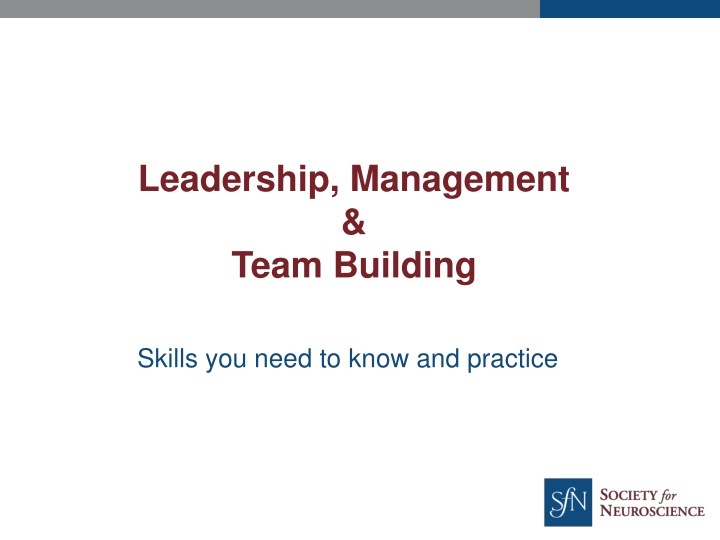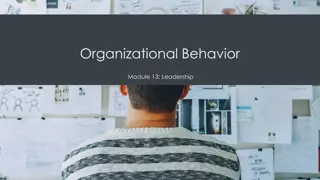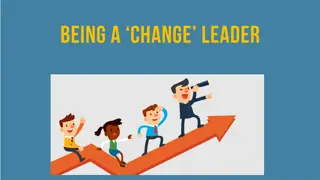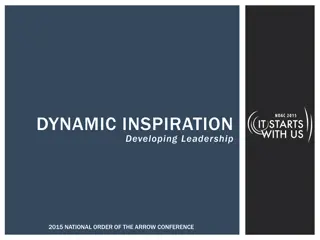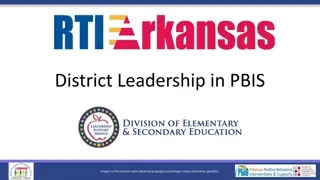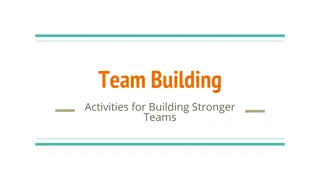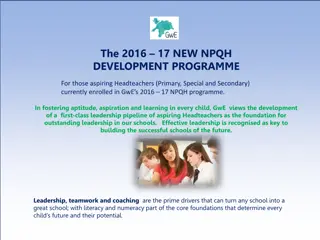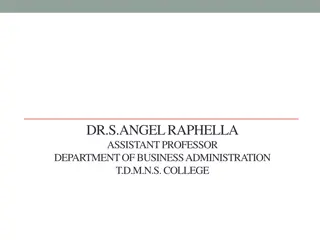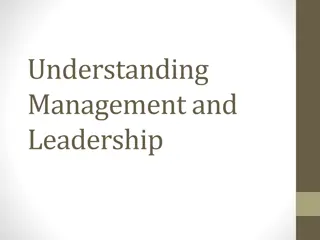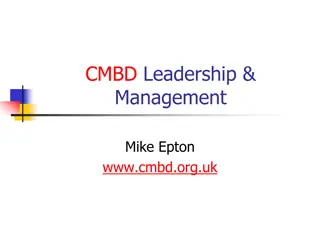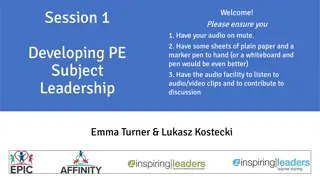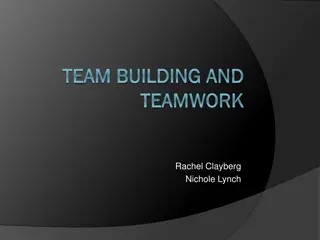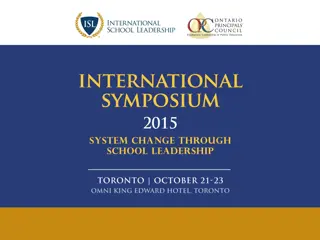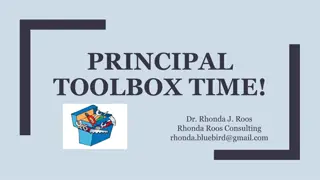Essential Leadership, Management, and Team Building Skills
Learn about the core competencies in leadership and management crucial for (neuro)scientists and principal investigators. Discover the importance of effective leadership styles and building high-performing teams to excel in scientific endeavors and global collaborations.
Download Presentation

Please find below an Image/Link to download the presentation.
The content on the website is provided AS IS for your information and personal use only. It may not be sold, licensed, or shared on other websites without obtaining consent from the author.If you encounter any issues during the download, it is possible that the publisher has removed the file from their server.
You are allowed to download the files provided on this website for personal or commercial use, subject to the condition that they are used lawfully. All files are the property of their respective owners.
The content on the website is provided AS IS for your information and personal use only. It may not be sold, licensed, or shared on other websites without obtaining consent from the author.
E N D
Presentation Transcript
Leadership, Management & Team Building Skills you need to know and practice
Core Competencies Leadership, management and building effective teams are critical roles (Core Competencies) for (neuro)scientists and principal investigators now and in the future. According to the National Postdoctoral Association in addition to becoming a subject matter expert and achieving independence during a postdoctoral fellowship, six additional core competencies, including Leadership and Management Skills , should be gained during this period. The aim of this short presentation is to expose participants to effective leadership and management styles, as well as what makes high performing teams www.nationalposdoc.org/?corecompetencies
Content Leadership Management Team building
Content Leadership Management Team Building
The Leadership Drought Leadership development is the #1 priority for organizations in the world. The challenge is urgent and growing in importance - 89% of executives rated the need to strengthen, re-engineer, and improve organizational leadership as an important priority. - The profile for top leaders is complex and evolving Leaders of top scientific efforts (PIs) today and in the future require understanding how to lead global collaborations with labs around the world how to conceptualize new and faster solutions to scientific problems by leading public-private partnerships (including academic labs, for-profit interests, governments and other stake-holders) to achieve their own unique goals how to discern and integrate new areas of knowledge and scientific progress into existing programs/collaborations to ensure optimal outcomes what skills are needed to develop and train the next generation of diverse scientists and researchers Global Human Capital Trends 2016 The new organization: Different by design, Deloitte University Press
Leadership Definition If your actions inspire others to dream more, learn more, do more and become more, you are a leader John Quincy Adams
Leadership Basic leadership skills (1/2) 1. Integrity - Principled - Honest - Treats others as they wish to be treated - Passionate about beliefs - Perseveres when the going gets tough - Alignment between actions and words 2. Vision - Sees the future of where things need to be and attracts commitment and energizes people creates meaning in the lives of followers establishes a standard of excellence bridges the present to the future transcends the status quo. Communicates effectively to paint the picture and inspire others towards the future state that you perceive -
Leadership Basic leadership skills (2/2) 3. Communication - Consummate leaders need to know how to share as well as how to seek information what to communicate to whom and when how to choose the appropriate medium of communication is how to communicate with large and small audiences when not to communicate. - Do you listen more than you speak? - Do you communicate with your person as well as with words? - How do you handle confidential information or bad news? 4. Developing People - Encouraging, helping, coaching and/or mentoring people to stretch and grow their capabilities beyond their current status. People follow you because of what you do for them. Do you exude and instill trust and respect in those around you? Do you have superior networking, interpersonal and group communication skills?
The Ultimate Leader The best leaders are also good managers, although it is rare to find the best traits of both in one person Everything rises and falls on leadership John C. Maxwell
Leadership Skills gained at graduate school/postdoc fellowship Facilitate group discussions or conduct meetings Respond appropriately to positive or negative feedback Collaborate on projects Effectively mentor subordinates and/or peers Teach skills or concepts to others Motivate others to complete projects Navigate complex bureaucratic environments Vision to see what is needed to advance a scientific area https://careercenter.umich.edu/article/phd-transferable-skills
Leadership Key take-away messages Some leadership skills are learned during graduate school and postdoctoral fellowships, but many require additional and targeted training. Leadership can be taught. Leaders of (neuro)science in the future need to be more than subject matter experts. They need to be able to lead people in complex collaborations such as public-private partnerships. There are various leadership styles, but the best leaders exhibit integrity & vision, are consummate communicators and focus on developing people over projects.
Content Leadership Management Team Building
Management Definition Management can be simply defined as the organization of processes and people to achieve a desired result Good management is the art of making problems so interesting, and their solutions so constructive, that everyone wants to get to work and deal with them. Paul Hawken
Six Management Styles Based on Daniel Goleman s classic study (Harvard Business Review, 2000) of more than 3000 mid-level managers Directive Authoritative Affiliative Participative Pacesetting Coaching - The do it the way I tell you manager - The firm but fair manager - The people first, task second manager - The everyone has input manager - The do it myself manager - The developmental manager 6 Management Styles and When Best To Use Them The Leaders13 Tool Kit, The Huffington Post, April 16, 2013 Rosalind Cardinal
Management Characteristics of great managers Stellar managers create superior dynamics where teams: - achieve great results because team members trust one another - work seamlessly with one another - are excellent at making decisions - hold one another accountable for making things happen
Management Basic management skills (1/2) 1. Plan - What is the SMART goal? Specific Clear and detailed objectives which is significant if achieved Measurable Can be achieved, quantified and meaningful, even motivational to the team Agreed The team involved needs to agree to it. It needs to be attainable and action-oriented Realistic The goal needs to be relevant, reasonable, rewarding and results-oriented Timely The goal should be tangible and able to be tracked using deadlines What is the desired result? What is the complexity and what are the options? What will it take to achieve success? - - - 2. Organize - This is where the rubber hits the road and all the plans in the world are ineffective without organized and synchronized execution Are the right people involved and do they understand their roles? Are the right tools and processes in place? It timing coordinated? What happens when the task is accomplished? Is there a hand-off?
Management Basic management skills (2/2) 3. Direct - Once the planning and organization is completed and the project begins, the role of the manager turns to orchestrating flawless execution by and of: People Systems Timing 4. Monitor - Checking on the project on a regular basis via systematic review of each step is important because issues arise. This is where you are able to determine whether you could operate on your optimal plan to over-deliver or engage alternative options when problems arise. Tracking Trouble-shooting Tweaking Motivating Encouraging
Management Skills gained at graduate school/postdoc fellowship Work effectively under pressure with deadlines Comprehend new material and subject matter quickly Work effectively with limited supervision Manage projects from beginning to end Identify goals and/or tasks to be accomplished and a realistic timeline for completion Prioritize tasks while anticipating potential problems Maintain flexibility in the face of changing circumstances https://careercenter.umich.edu/article/phd-transferable-skills
Leadership versus Management Leaders Managers Create the vision (What) Execute the vision (How) Transformational Transactional Long-term Short-term Innovate breaks rules Maintain make rules Inspire people Inform people Challenge the status quo Clarify the status quo Accept failure Resist failure Heart Passion People Head Control Processes Seeing & Selling Doing & Telling Management is doing things right; leadership is doing the right things Peter F. Drucker
Management Key take-away messages There are various management styles, but good management requires planning, organization, direction and monitoring. During graduate school and postdoctoral fellowships some management skills are attained, but many require mastering such as managing projects through teams Leadership and management are two different skill-sets and it is rare to find someone who exemplifies top traits of both.
Content Leadership Management Team Building
Team Building Stages Forming - - Defining the team, charter, roles, tasks, strategy Developing trust and communication Storming - Working through the challenges related to the tasks, processes and persons Norming - - - Acknowledgment of the team strengths and weaknesses Acceptance of members Harmonize working Performing - Harmonized working and achieving results together "Developmental sequence in small groups". Psychological Bulletin. (1965) 63 (6): 384 399. Bruce W. Tuckman
High-Performing Teams Definition A team is a small number of people with complementary skills who are committed to a common purpose, set of performance goals, and approach for which they hold themselves mutually accountable. The Discipline of Teams, Jon R. Katsenbach and Douglas K. Smith (Harvard Business Review, July-August, 2005) Team effectiveness can be influenced by the personality types and traits of its individual members. Personality types are sometimes thought to involve qualitative, whereas personality traits maybe classified as quantitative differences between individuals. There are several models of assessment for both indices, e.g., MBTI, Five-Factor Model A high-performing team (HPT) is committed, coordinated, focused, adaptable and has diverse skills and talents communicates optimally aligns itself around key initiatives creates short-term/long-term plans takes ownership of key accountabilities holds itself accountable to deliver the required results None of us are as smart as all of us The New Science of Building Great Teams, Alex Sandy Pentland (Harvard Business Review, April, 2012)
High-Performing Teams Group Dynamics The best teams invest a tremendous amount of time and effort exploring, shaping and agreeing on a purpose that belongs to them both collectively and individually. This purposing activity continues throughout the life of the team. The Discipline of Teams, Jon R. Katsenbach and Douglas K. Smith (Harvard Business Review, July-August, 2005) Group dynamics of HPTs centers on how teams communicate and operate:- - Energy How team members contribute to the team Everyone on the team talks and listens in roughly equal measure Keep contributions short and sweet Take ownership - Engagement How team members communicate with one another Connect directly with one another, not just the team leader Side-conversations within the team - Exploration How team members educate each other Seek fresh perspectives from other groups Bring information back to the team
X-Teams Innovative teams Teams can be insular and this can be self-limiting. The concept of X- teams brings excellence to teams by seeking expertise and input external to the team. Advances in the area of scientific endeavor can come from seeking knowledge and experience external to the lab, PI or even the field of acknowledged experts Principles - - - High level of external activity Combined with extreme execution Incorporate flexible phases Structure - - - Extensive ties to others outside of the team Expandable tiers Exchangeable membership If the need for innovation, flexibility and coordination is not clear, then a traditional team may be a better solution. X-Teams , Deborah Ancona, Henrik Bressman, Harvard Business School Press, 2007
5Dysfunctions of a Team 1. Absence of trust The fear of being vulnerable with team members prevents the building of trust within the team 2. Fear of conflict The desire to preserve artificial harmony stifles the occurrence of productive ideological conflict 3. Lack of commitment The lack of clarity or buy-in prevents team members from making decisions to which they will stick 4. Avoidance of accountability The need to avoid personal discomfort prevents team members from holding one another accountable 5. Inattention to results The pursuit of individual goals and personal status erodes the focus of collective success Dysfunctional teams may not prevent achieving team goals, but they are likely to be ineffective teams The Five Dysfunctions of a Teams , Patrick Lencione, Jossey-Bass, a Wiley imprint, 2002
Team Building Key take-away messages Building effective teams takes time and effort as they evolve through different stages of development High performing teams consists of individuals o with diverse personalities o aligned and committed around a unified goal o accountable, individually and as a team o who have open communication & use conflict to their advantage o who seek expertise outside of themselves o who trust each other o who are results-oriented https://careercenter.umich.edu/article/phd-transferable-skills
Leadership, Management & Team Building What s next? Understand your personal talents, skills and traits and whether you are a more effective leader or manager? What teams are you a part of and what is your role on each team? Build your team with people whose skill-sets complement your areas of weakness - Expand this to include personal and professional teams, e.g., your family and your social groups - Regardless of your role on the team, remember that effective leaders are also great followers An effective (team) leader must: - be selfless - set the tone - be objective - focus on achieving results Determine what you need to do in the next month to start to sharpen your skills and build an effective team. Respond to the growing leadership drought and expand your leadership, management and team building skills. It is not the most intellectual of the species that survives; it is not the strongest that survives; but the species that survives is the one that is able best to adapt and adjust to the changing environment in which it finds itself. Charles Darwin
Other References 100 Answers to the Question: What Is Leadership? Lolly Daskal, President and CEO, Lead From Within http://www.inc.com/lolly-daskal/100-answers-to-the-question-what-is-leadership.html Harvard Business Review - What Great Managers Do, Marcus Buckingham, March 2005. Nanus, B. (1992). Visionary leadership: Creating a compelling sense of direction for your organization. San Francisco: Jossey-Bass. The Complete Leader, Ron Price & Randy Lisk, Aloha Publishing, January, 2014. Vision, Leadership, and Change Southwest Educational Development Laboratory (SEDL) merged with the American Institutes for Research (AIR) on January 1, 2015. This archived website contains the work of SEDL legacy projects and rich resources from the past 50 years. http://www.sedl.org/change/issues/issues23.html
